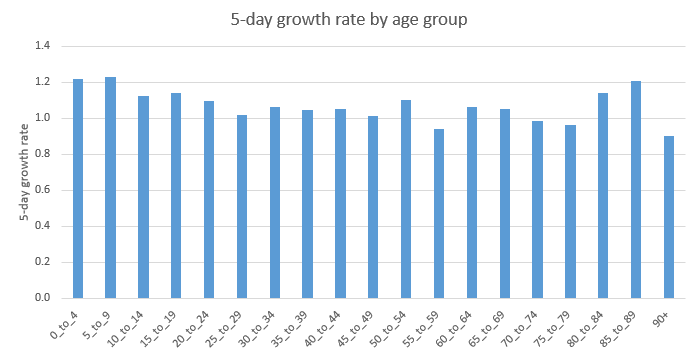
I think the age dynamics of the current case growth are interesting, particularly as they have shifted in the last week or two. Growth is now very clearly dominated by the 20-30s, while growth in school-age children has tailed off: 1/6 

If we look more closely e.g. at 5-9 year olds, we can see that tailing off of growth. I’m not 100% sure why this has happened, it seems slightly early for a half term effect, so maybe local PH efforts and bubble closures are having an impact? &/or parents being vaxxed?? 2/6 

Meanwhile the growth in 20-24s is pretty dramatic, doubling in just under a week, and now back to levels not seen since February: 3/6 

Of course, if the growth stays in those younger age groups, and the “vaccine wall” remains intact to stop it spreading upwards, we should be OK (and will see little impact on hospitalisations and death stats). So, how is that wall looking? 4/6
Well, OK-ish, but a bit porous. There’s some moderate growth in the (mostly single-vaxxed) 35-60s, and lower growth in the (mostly double-vaxxed) over-60s. That’s consistent with what we know about the immunity escape on Delta (i.e. more escape for 1 dose than 2). 5/6 

So what we need now is for first-dose vaccinations to pull down the growth in 20-35s (and stop them infecting others) while second doses keep a lid on what’s happening in the 40-60s who still have a moderate risk of hospitalisation. It’s doable, but the timing is critical. /end
should have said:
a) this is data from the gov.uk dashboard, using the femaleCases and maleCases series for England.
b) the data for 85+/90+ is quite noisy as based on very small case numbers (good news!) so the growth rate there is nothing to worry about.
a) this is data from the gov.uk dashboard, using the femaleCases and maleCases series for England.
b) the data for 85+/90+ is quite noisy as based on very small case numbers (good news!) so the growth rate there is nothing to worry about.
• • •
Missing some Tweet in this thread? You can try to
force a refresh





